Darwin’s Natural Raw Dog Food Review
I’ve fed my Dachshunds Darwin’s Raw Dog Food off and on for years.
I think it’s high quality, I love that I can have it delivered, and the company is based here in Western Washington so I can feel good about supporting a small, local company.
In this article, I share my experience with the Darwin’s raw diet to help people that may be considering it for their dog.
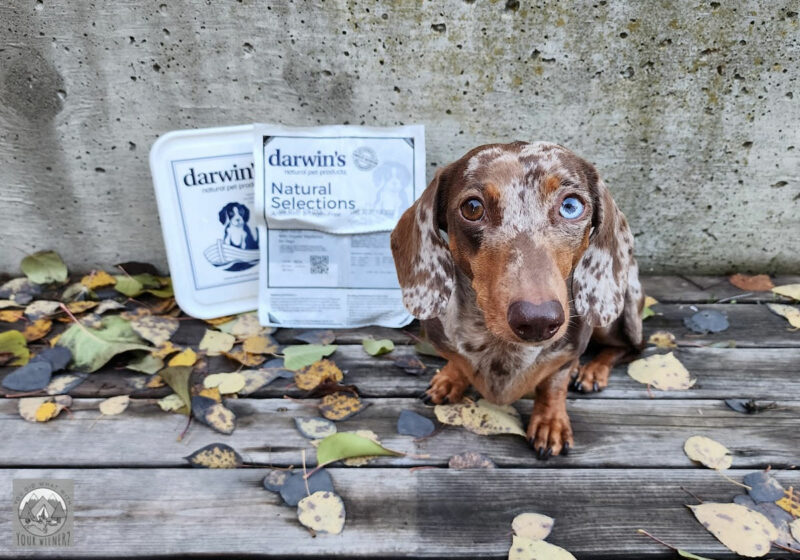
About Darwin’s Raw Dog Food
Darwin’s Raw Dog Food is made from high-quality, human-grade meats and vegetables.
Darwin’s raw meal formula is:
- 75% meat
- 25% vegetables
- Gluten-free & grain-free
- Free of steroids, hormones, and antibiotics
- A nutritionally balanced complete meal
- High in protein, moderate in fats, and low in carbohydrates
With that being said, there are three different meal types available on their website.
Darwin’s Natural Selections™
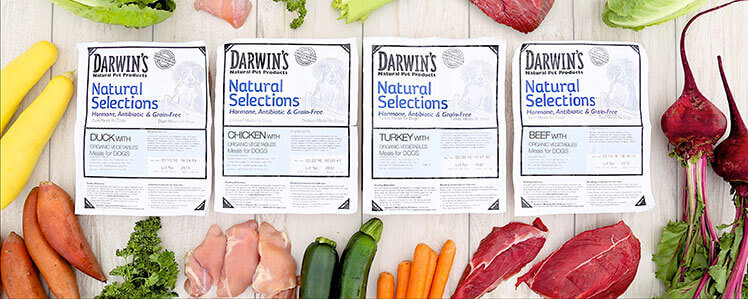
Darwin’s Natural Selections™ is their premium recipe line of raw dog food made from cage free (free-roaming), pasture raised, or grass fed (depending on the proteins) meats and organic vegetables.
Darwin’s BioLogics™
Darwin’s BioLogics is their value line.
It uses the same complete and balanced formula as Natural Selections, but the formula is made from fresh, conventionally-raised and grown meats and vegetables.
Although the meats are not free range or grass fed, they are still hormone and steroid-free.
The vegetables used are from the same farms that supply supermarkets.
Darwin’s Intelligent Design™
For dogs with special needs, they also have an Intelligent Design™ line (available by prescription only) which includes a kidney, liver, cancer, and joint & musculoskeletal support formulas.
From what I can tell on their website, this food is based on the Natural Selections formulation, but may have less of one ingredient, or an additional one, to address specific health issues.
What Makes Darwin’s Raw Dog Food Different?
Darwin’s raw dog food was one of the first that I heard of and definitely the first I was aware of that delivered.
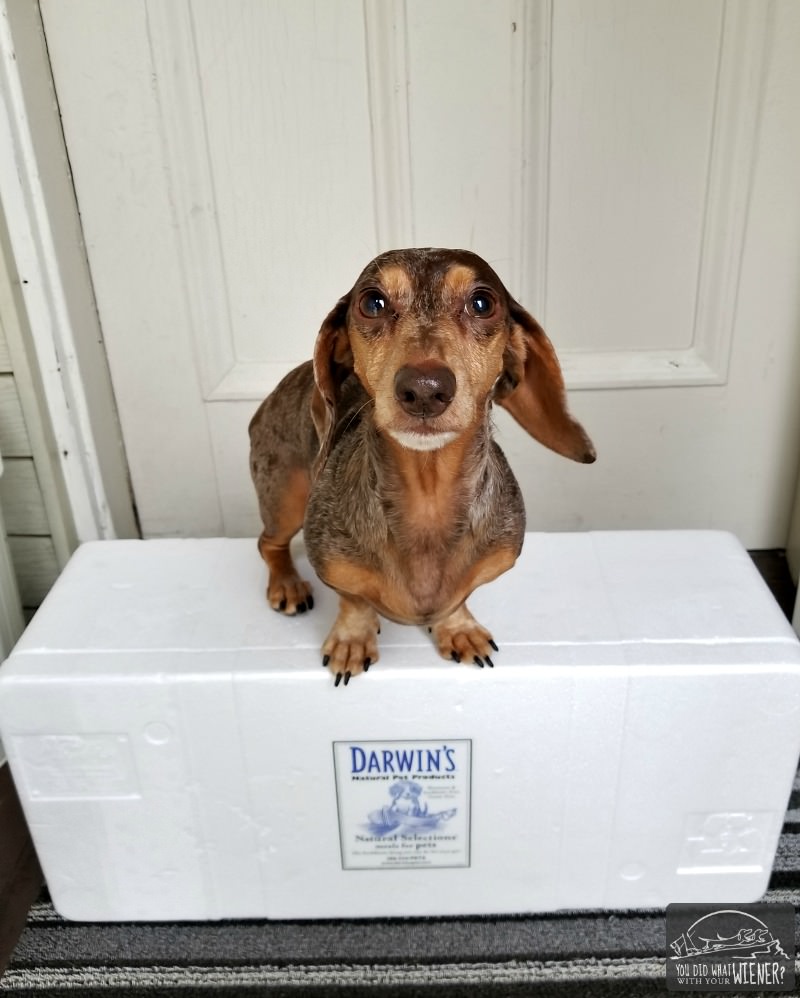
Today, there are many raw dog foods on the market and at least a dozen of companies that will deliver the food directly to you.
So what makes Darwin’s stand out to me?
- Gary, the company’s founder, started in his own kitchen making raw food to address his own dog’s health issues. He refined his formulation through years of experience.
- Darwin’s offers a free menu consultation (for both new and existing customers) if you are not sure what or how much to feed your dog.
- You can place an introductory 10 lb order for $14.95 to test out the food before fully committing to a subscription.
- Shipping is free for orders that are 20 or more pounds, except to Hawaii and Alaska. Orders under this amount are charged a $10.00 flat rate shipping fee.
My Experience With Darwin’s Raw Dog Food
I tried Darwin’s for the first time around 2014.
I signed up with their introductory offer for new customers, but went back to getting my Dachshund’s frozen raw dog food in person from the pet store after almost a year.
However, after trying several different brands of raw dog food, I came back to Darwin’s.
Note: If you’ve been following us you know I like to rotate dog’s food regularly.
To this day, Darwin’s food is still one of the raw foods in our rotation.
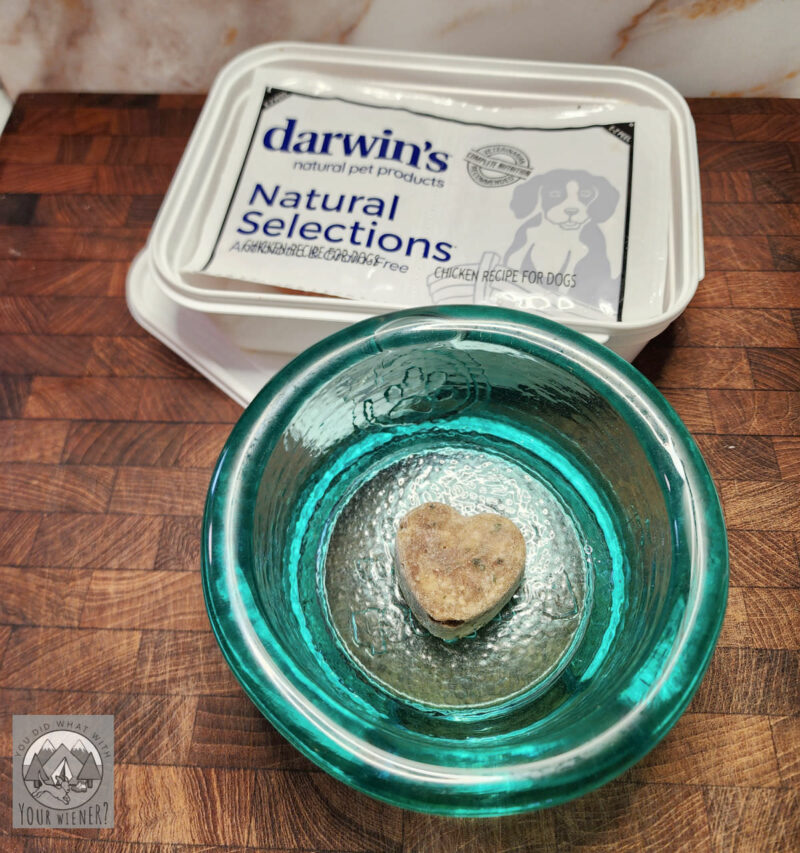
My favorite ways to use Darwin’s food are:
- As a complete meal when I want to feed a raw meal without adding organs and vegetables myself
- In a Kong or on a lick mat so that I know my dogs will go nuts and they are getting balanced nutrition instead of junk food
- When I get tired of having to run to the pet store all of the time
The food comes in individual pouches. I neither like or dislike this.
The biggest plus for Darwin’s is that the pouches are easy to open, even with wet hands.
I don’t use an entire pouch, even to feed two miniature Dachshunds one meal, so there is always a partially opened pouch in the refrigerator.
It would be nice if there was an option to buy a bulk container so less packaging is used, but the individual pouches help prevent the food from being contaminated by bacteria.
Given that they individual packages are not a hassle to open, I’ll take the tradeoff.
The food comes in 2 lb packages and each package is made up of 4 half pound smaller packages joined together.
The plastic is well perforated so each portion can be separated without using scissors.
The cost of each 2 lb package varies by meat flavor, but ranges from $13.64 for chicken to $22.41 for lamb.
When you place a full order (not introductory), you will take a quiz and enter details about your pet like gender, age, and ideal weight.
Darwin’s will then use this information to suggest a delivery amount and frequency.
Shipments have always arrived in a timely manner, without damage, and the food was still frozen It’s shipped with dry ice).
I would describe consistency of the food as a meat and veggie mash.
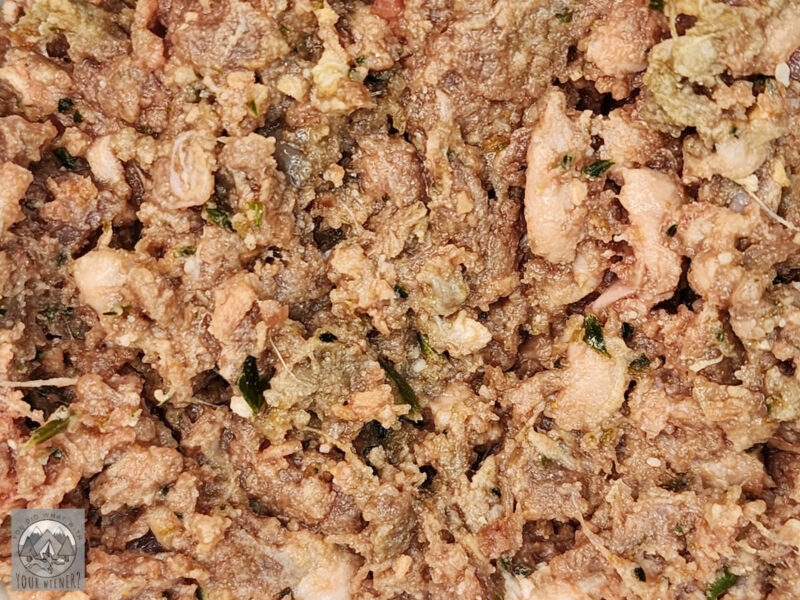
The food contains a lot of moisture, and the ingredients are ground into small pieces.
However, unlike some raw food that is ground so fine you can no longer see the individual ingredients, they are somewhat identifiable in Darwin’s raw food.
Is Darwin’s Raw Pet Food Safe? Have There Been any Recalls?
As a concerned pet owner, you are probably wondering if there have been been any recalls for Darwin’s frozen raw dog food.
If you don’t know about them already, at some point, you will probably discover that there have been voluntary recalls of Darwin’s raw food, and a couple Food and Drug Administration (FDA) warnings, in the past.
Darwin’s pet food is monitored for potentially unsafe bacteria both by the company and by the FDA.
The FDA maintains a zero-tolerance policy which disallows any presence of Salmonella, even in quantities too low to cause harm to either humans or pets, in pet food.
Bottom line: there have been no illnesses reported from eating Darwin’s raw food but there have been a couple voluntary recalls and warnings about alleged bacterial contamination. I feel it’s a safe food, but make that judgement yourself.
According to my knowledge and DogFoodAdvisor (which gives Darwin’s raw food 5/5 stars), this is the recall history:
- 2017 – voluntary recall by Darwin’s as a result of internal testing that detected potential Salmonella contamination. No pet illnesses were reported to the company.
- 2018 – voluntary recall by Darwin’s as a result of internal testing that detected potential Salmonella contamination in a single case of dog food. No pet illnesses were reported to the company.
- 2018 – voluntary recall by Darwin’s as a result of internal testing that detected potential Salmonella and/or E. Coli contamination. No pet illnesses were reported to the company.
- 2019 – the FDA issued a public warning after testing indicated Salmonella contamination. No pet illnesses were reported to the company.
Important note: Darwin’s had already contacted customers who indicated the food had already been consumed with no issues. The FDA issued the warning after Darwin’s refused to turn over private customer data.
- 2023 – the FDA issued a public warning after testing indicated Salmonella contamination. No pet illnesses were reported to the company.
You can read the official statement by Darwin’s made after the most recent FDA warning HERE.
I think it’s relevant to mention a couple of points here:
- The digestive system of most dogs is able to process pathogens such as Salmonella or E. coli without harm, unless they are already ill with some other condition.
- Likewise, humans are typically unaffected by low levels of bacterial contamination unless they have an underlying health issue or compromised immune system.
- Recalls are not something that only happens with raw food. Voluntary recalls have been made on all forms of food in the past – kibble, canned, and raw.
Personally, I am zero worried about these voluntary recalls and warnings.
In fact, voluntary recalls tell me that they company is monitoring their food for safety and always erring on the side of caution.
Neither my dogs or I have significant health issues or compromised immune systems though.
Disclosure: I love Darwin’s Raw Dog Food and buy it myself. However, they have sent me a couple shipments in the past at no cost in exchange for sharing my thoughts with you.
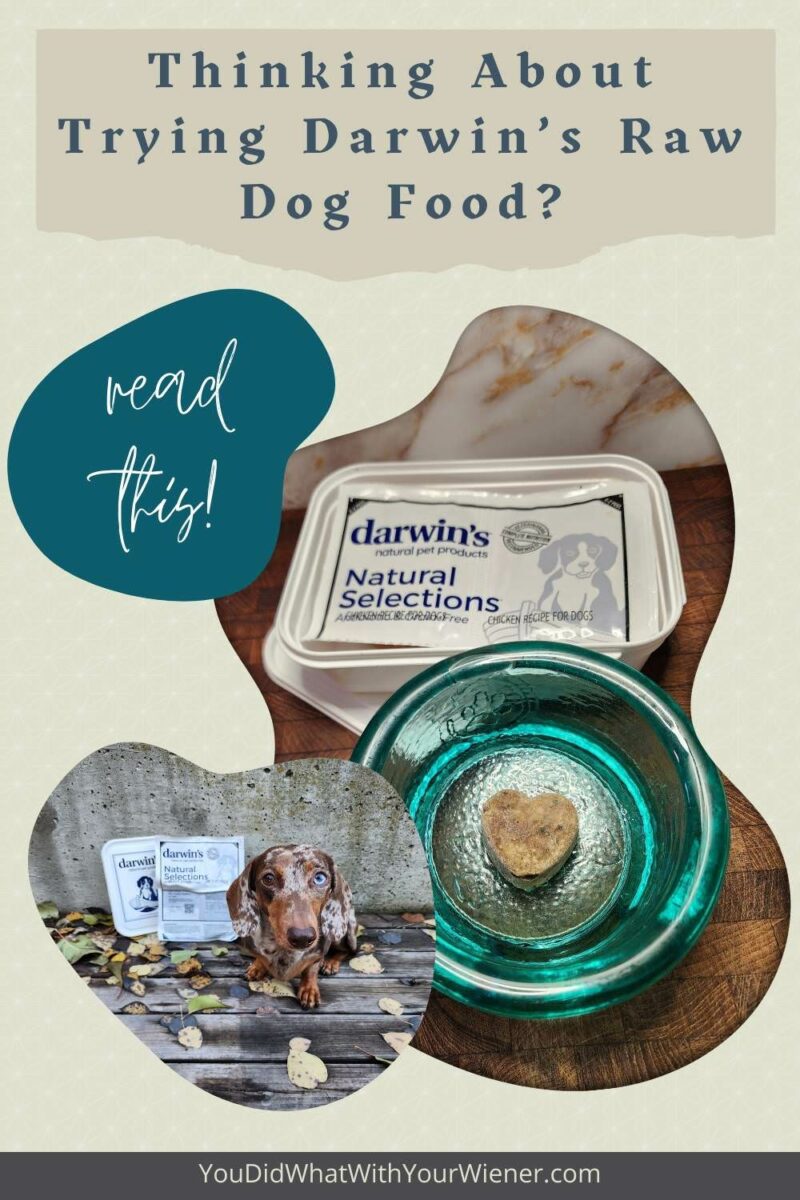
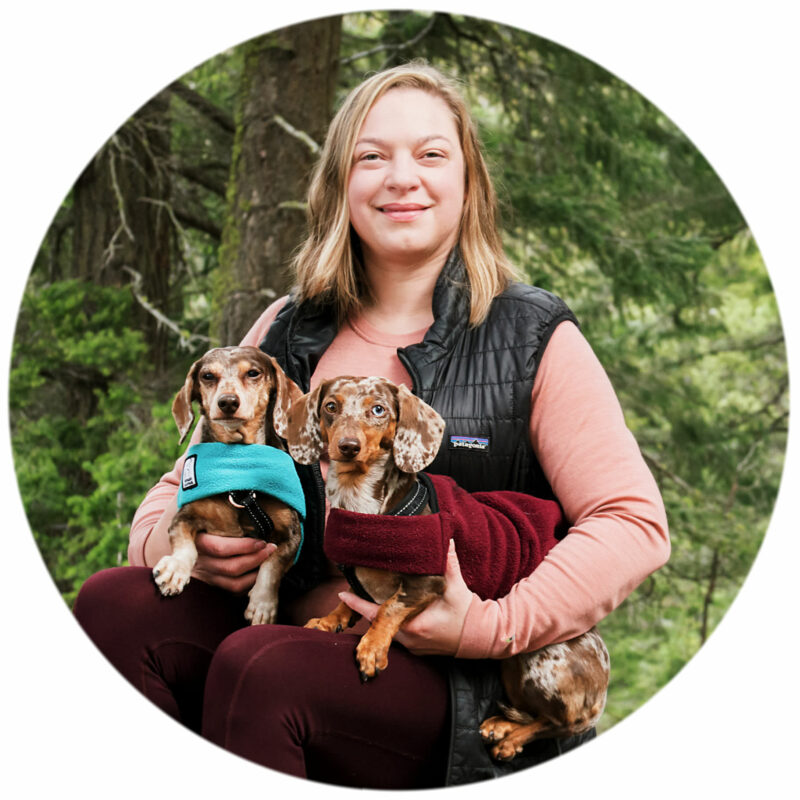
About the Author
Hi, I’m Jessica. I’ve been studying the Dachshund breed since 2007, owned 3 of my own, and shared in the lives of thousands of others through their owner’s stories. When I’m not sharing what I know on this blog, you can find me hiking, camping, and traveling with my adventurous wiener dogs.

You mentioned raw food “gives them more energy”, like that’s a GOOD thing for dachshunds??! heehee ;o)
Ha, ha. Right? Seriously. My hubby and I joked after Chester became super spunky that maybe we liked him a little more lethargic 🙂 It definitely took an adjustment.
I hardily second the recommendation for raw food, and we have been subscribers of Darwin’s since Buddy Orion become a part of our family at 3 months old. All the things you mention above are exactly the reasons we love it, he loves it (he actually races to the kitchen each morning waiting by his bowl) and smaller compact poops, he has a very shiny and silky coat, healthy teeth, etc. and tons of energy … well, he is only a year old though. Anyway, we had used a raw meaty diet with a family dog several years ago with bad allergies, and it was the diet that solved his problem … our next family dog (a Border Collie) ate a diet of grain free kibble, with some fresh bones – she lived to be 15 years old, but I do often wonder how a raw diet would have different for her. Because Buddy is small, his daily portion of food is not that large so, for us, Darwin’s has been a really good deal for us … free delivery, and whenever you want to change your date – there is no muss or fuss, they just adjust the date, it is really hassle-free. Also, I have found their customer service to be very good as well – and I was happy to find they are a local company, so it’s a win-win in my book.
We are also raw advocates, my oldest pup has been raw fed for around 7 months now and when our youngest pup came home 4 months ago she was transitioned too. We first started raw because of the amazing benefits it has but also because my oldest pup is an itchy dog. Something in kibble does not agree with her (and the fact she pretty much refused to eat it, I don’t blame her with being so itchy). Switching to raw was like the light at the end of the tunnel within days she stopped itching and become a happier and healthier dog. I’m so happy to read raw food blogs and I’m hoping that it will become more popular with the whole pet community!
I’m so glad raw food helped with the allergies. I know many people who have made the switch for the same reason.
I know the Raw Food Diet may not be for everyone and that’s okay. However, the Raw Food Diet has worked well for my doggie family. It can be a pain in the butt for me at times because I have six dogs. Three of my dogs are between 5-7lbs. The other three weigh 70lbs, 110, and 125lbs. I purchase and use several different raw food brands. I too don’t like to use the same dog food every single day for a long period of time. I like to switch their diet around every six months to year. Some of my personal favorite brands are Darwin, Raw Wild, and Stella and chewy’s (mainly for traveling). Since I have three huge dogs whom are very expensive to feed a lot of times I make my own raw dog food and freeze it. I’m lucky enough to have a very generous husband who spoils me and our furry children with their own freezer. If expense is a concern save your money for a vitamix blender! I know they’re very expensive but in the long run they will save you thousands of dollars on dog food. I also know not everyone wants to make their own a dog food. It’s just it cost me over hundred dollars a day when I have to buy a raw food diet for my big dogs!
Your dogs sound very lucky Terry 🙂 I have a Vitamiz. Do you just use it to blend the veggies or the meat too? I never thought of blending dog food in it.
I switched to Darwin’s from a different raw dog food brand and it made my dogs sick! Then I heard they had a recall on the food and I immediately took them off of it. It was back to the computer to do more research and switch their food again.
I’m sorry you had that experience George. I know they did issue a few voluntary recalls just a bit ago. I don’t worry much about voluntary recalls because they basically mean there are no serious threats but the company cares enough about pets that they don’t want to take any risks. However, some pets CAN be affected by even low levels of pathogens like salmonella.
You’re lucky that you folks probably live in the same state? I ordered once before and I would like to order again being 5 years ago when I received an order maybe $300 worth but of course shipping was about the same price as the food. Or kind of close. Let’s say $600 a month, maybe, as I don’t remember precisely what I paid but I know that shipping was around the price of my golden retriever’s food, packed in foam and dry ice, well boxed.. and not complaining just that $175 for pet insurances, rack of lambs, not as often as I need to drive 25 miles through heavy traffic to get to Whole Foods as that’s the only place that has the racks from New Zealand and mostly needs to be the New Zealand’s as their racks of lambs, the bones are smaller, (poor lambs) as those are lambs. Safeway has grass fed but much larger, thicker bones being older sheep I feel. But of course I would want Darwin’s, but it’s been a while. Would you know of pet guardians willing to pay $700 monthly? I feel it’s about what costs now would be. Thanks, I told myself to stay off this smartphone and here I go again!
Hi Gary. Yes, I do live in the same state as their company is based. I used to live in their “free delivery area” but now I do not but I’m still fairly close. I assume the delivery fee is more the further you live from Seattle and agree that those shipping costs seem a bit prohibitive. I think my total budget for food, treat, goodies, etc for my two dogs is no more than $400-$500 a month. I’m glad you were able to find some bones and meats closer to you for less.
We used Darwin’s for quite some time with our goldens. We loved the quality and I’d use it again. But, I just can’t convince my two Havanese to eat true raw. So, I’ve settled on freeze-dried raw in the mornings and lightly cooked at dinnertime.
Great details – thanks for spreading the word about raw benefits.
I’m always surprised when I hear that a dog won’t eat raw meat. Like, are you even dog?? Ha, ha. I can see that yours might have a refined palate though 🙂